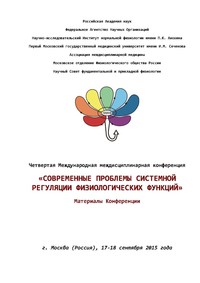МЕХАНИЗМЫ РЕГЕНЕРАЦИИ ГЕМОПОЭЗА ПРИ МИЕЛОИНГИБИРУЮЩИХ ВОЗДЕЙСТВИЯХ
Бесплатно
Основная коллекция

Издательство:
НИИ ноpмальной физиологии им. П.К. Анохина
Год издания: 2015
Кол-во страниц: 3
Дополнительно
Скопировать запись
Фрагмент текстового слоя документа размещен для индексирующих роботов
specific formalism for the links between different functional systems. It also does not explain the origin of traditional psychological phenomena and functions from the activity of functional systems. Finally, it does not address the issue of development and dynamics of distributed neuronal systems that do not contribute to adaptive results of the organisms. All these questions are the subject of the extended functional systems theory (EFST). It introduces the concept of cognitive hypernetwork of the brain (cognitome).The vertices of this hypernetwork are neuronal cognitive groups (COGs) subsets of vertices from the underlying neural network (connectome) associated by a common cognitive experience. Edges between vertices in the cognitive network are formed by the combination of edges between of corresponding vertices in the neural network. They possess emergent cognitive properties not reduced to underlying neural connections. Thus, cogs represent nodes in the cognitome and edges are links between them. Building on the concept of cogs and their links, we can represent cognitome as a network. This allows introducing mathematical formalism into description of cognitive experience. In terms of algebraic topology, COG is a relational simplex or hypersimplex, It's base is the simplex from vertices of the underlying N-network and its apex is the vertex possessing a new quality at the higher-level K-network. Hypernetworks generalize networks and hypergraphs, provide formalism for description of emergent phenomena in the multi-level systems, and allow modeling much more complex structures than networks and hypergraphs. According to the EFST, these hyperstructures compose a unified system of individual experience of the organism its cognitome. LITERATURE 1. P.K. Anokhin. Essay on Physiology of Functional Systems. 1975, Medicine, Moscow. DOI:10.12737/12261 МЕХАНИЗМЫ РЕГЕНЕРАЦИИ ГЕМОПОЭЗА ПРИ МИЕЛОИНГИБИРУЮЩИХ ВОЗДЕЙСТВИЯХ Дыгай А.М., Жданов В.В. Федеральное государственное бюджетное научное учреждение «Научно исследовательский институт фармакологии и регенеративной медицины имени Е.Д. Гольдберга», Томск, Россия Важное значение в восстановлении гемопоэза при миелоингибирующих воздействиях принадлежит цитокинам, продуцируемым элементами кроветворного микроокружения. В выработке данных веществ принимает участие целый ряд сигнальных каскадов, знание роли отдельных компонентов которых необходимо для разработки новых способов и средств для коррекции гипопластических состояний. Цель исследования. Определить общие закономерности и особенности сигнальной трансдукции в регуляции кроветворения в норме и при действии различных цитостатических
препаратов. Материал и методы. Эксперименты выполнены на мышах линий СВА/CaLac и С57Bl/6. Использованы гематологические, культуральные, иммунологические методы исследования. Результаты. Показано, что в физиологических условиях фармакологическое выключение определенных сигнальных каскадов, участвующих в регуляции кроветворения, компенсируется параллельно функционирующими путями трансдукции. При цитостатических миелосупрессиях, приводящих к нарушениям межклеточных взаимодействий, определяющим для гемопоэтической репарации является спектр секретируемых клетками кроветворного микроокружения гуморальных субстанций, в продукции которых ведущую роль играет р38 МАР-киназный сигнальный путь. Полученные результаты свидетельствуют о том, что процессы пролиферации и дифференцировки кроветворных клеток, а также продукция элементами ГИМ гуморальных регуляторов кроветворения при действии на организм различных по своей природе экстремальных факторов, реализуются при участии сигнальных путей, отличных от участвующих в трансдукции регуляторных сигналов в условиях равновесного кроветворения. MECHANISMS OF HEMOPOIESIS REGENERATION UNDER MYELOINHIBITORY INFLUENCES Dygai A.M., Zhdanov V.V. Federal State Budgetary Scientific Institution “Research Institute of Pharmacology and Regenerative Medicine named after E.D. Goldberg”, Tomsk, Russia Cytokines produced by hemopoietic microenvironment elements play a significant role in the hemopoiesis regeneration under myeloinhibitory influences. A number of signaling cascades is involved in the secretion of these substances. To develop new methods and drugs for correcting hypoplastic conditions is necessary to know the role of separate components of these cascades. The aim of the study is to identify general regularities and particularities of signal transduction in the regulation of hemopoiesis at normal conditions and under the effect of different cytostatic drugs. Material and methods. Experiments were carried out in mice of CBA/CaLac and C57BL/6 strains. Hematological, cultural and immunological methods were used in the study. The Results. Pharmacological blockade of certain signaling cascades involved in the regulation of hemopoiesis at physiological conditions was found to be compensated by parallel functioning pathways of transduction. Spectrum of humoral substances secreted by hemopoietic microenvironment cells, in the production of which p38 MAP kinase signaling pathway played leading role, was demonstrated to be determining for hemopoietic reparation under cytostatic myelosuppressions leading to the disruption of cell interactions. The obtained results proves proliferation and differentiation of hemopoietic cells and production of humoral regulators of hemopoiesis by HIM elements under influence of inherently various extreme factors on the body were realized with the participation of signaling pathways which differ from those
participating in the transduction of regulator signals at equilibrium hemopoiesis conditions. DOI:10.12737/12263 РОЛЬ МЕЖКЛЕТОЧНЫХ ВЗАИМОДЕЙСТВИЙ В РЕГУЛЯЦИИ ЭРИТРОПОЭЗА Ю.М.Захаров, И.Ю.Мельников Южно-Уральский государственный медицинский университет (ректор И.И.Долгушин), Челябинск zaharovum@chelsma.ru Эритропоэз у человека и млекопитающих протекает в эритробластических островках (ЭО), представленных «коронами» эритроидных клеток, окружающих макрофаги. Регуляция эритропоэза в ЭО осуществляется гормональной (эритропоэтин (ЭП) плазмы крови), симпатическской нервной и иммунной (Т-лимфоциты) системами, аутокринным и паракринным механизмами, функционирующими в ЭО по принципу положительной и отрицательной обратных связей. ЭП увеличивает: аффинность КОЕэ к макрофагам костного мозга, рост числа ЭО, пролиферации и дифференциации их эритроидных клеток; секрецию макрофагами ЭО эндогенного ЭП и глюкозаминогликанов, создавая эритропоэтическое микроокружение в ЭО; подавляет апоптоз эритрокариоцитов в ЭО. Снижение потребности тканей организма в О2 «включает» адаптивные ответы клеточных компонентов ЭО, тормозящих эритропоэз: снижается чувствительность к ЭП у макрофагов костного мозга, образование новых ЭО, митотической активности их эритроидных клеток, продукция эндогенного эритропоэтина и глюкозаминогликанов, в ЭО резко активируется синтез тормозящих эритропоэз цитокинов - ФНО-альфа, ИЛ-6. ROLE OF CELL-CELL INTERACTIONS IN ERYTHROPOIESIS REGULATION Yu.M.Zakharov, I.Yu.Melnikov. South-Ural state medical university (rector I.I.Dolgushin), Chelyabinsk zaharovum@chelsma.ru Key words: erythroblastic island, erythropoiesis, regulation of erythropoiesis. Erythropoiesis in human and mammals take place in erythroblastic islands (EI) formed by complexation of CFU-erythroid (or erythroblasts) with bone marrow macrophages [5]. Consequent doubling of initial CFU-erythroid cell or erythroblasts in an order 1:2:4:8:16:32 forms an erythroid “crown” of EI. The kinetic model of CFU-erythroid entering EI development and erythropoiesis pattern in its

